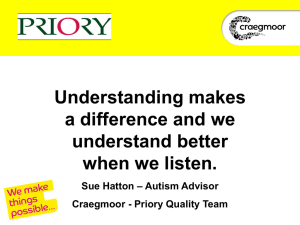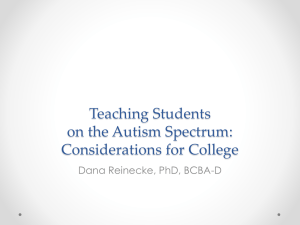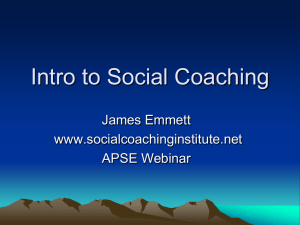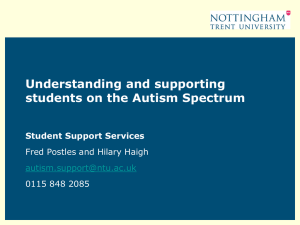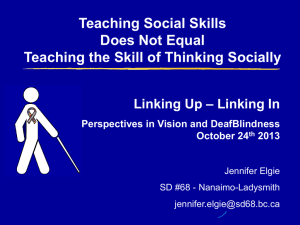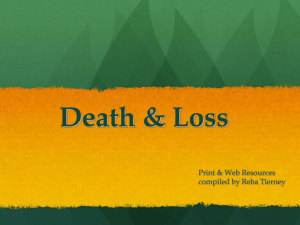Siblings and Autism
advertisement
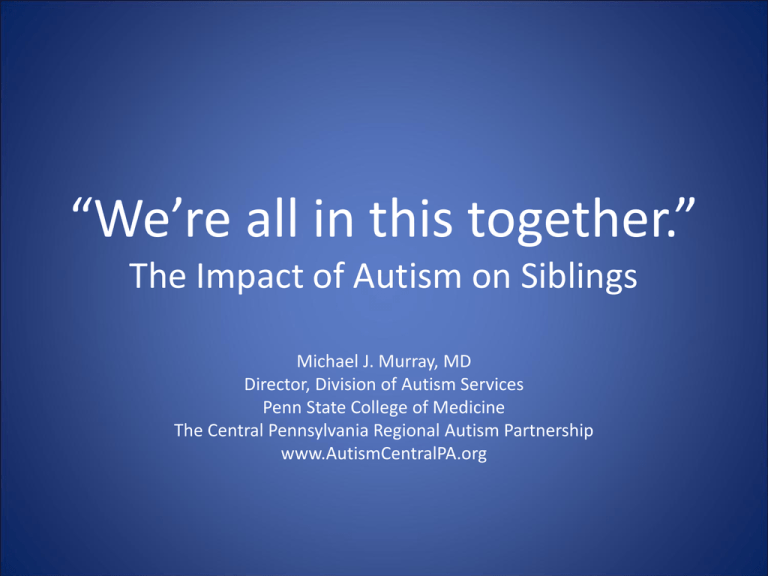
“We’re all in this together.” The Impact of Autism on Siblings Michael J. Murray, MD Director, Division of Autism Services Penn State College of Medicine The Central Pennsylvania Regional Autism Partnership www.AutismCentralPA.org Sibling: 1. A person’s brother or sister 2. The people we practice on, the people who teach us about fairness and cooperation and kindness and caring - quite often the hard way. “typical” Siblings • In many ways they are anything but typical: – Tend to be wiser and more mature than their age would suggest – Face myriad challenges: • Parental responsibility • Feelings of isolation from the rest of the family and their peers • Confusing feelings: fear, anger, and embarrassment about their sibling with autism • Guilt for having these feelings “typical” Siblings • "He had bigger needs than the rest of us and you can say it made me a better person, but you don't always want to be a better person, and that's the truth.“ – Judy Karasik Sources of stress for siblings: • embarrassment around peers • jealousy regarding amount of time parents spend with their brother/sister • frustration over not being able to engage or get a response from their brother/sister • being the target of aggressive behaviors Sources of stress for siblings: • trying to make up for the deficits of their brother/sister • concern regarding their parents’ stress and grief • concern over their role in future caregiving Explaining Autism to Children. Rule of thumb: talk about it early and often. Explaining Autism to Children. • Information needs to be relevant to their developmental age and understanding: – Young children may be most concerned about unusual behaviors that frighten or puzzle them. – Older children may be more bothered by interpersonal concerns such as explaining autism to their friends. – Adolescents may be most concerned with the long term needs of their sibling and the role they will play in future care. Explaining Autism to Children. • Children need to be told about autism again and again as they grow up: – Just because they can talk the talk does not mean they can walk the walk. – Throughout their childhoods, children will need to hear, in increasingly mature terms, what autism is all about. – When in doubt, let their questions about their brother or sister guide your discussion. So what do we know? You guessed it, not very much. The Research • Limitations – Few longitudinal studies – Strong cohort effects – Wide age ranges of included sibships – Most studies are self-report – Findings dependent on measure used Kaminsky and Dewey (2001) • Compared sibling relationships of children with autism, Down syndrome, and normally developing children • Sibling relationships in families with children with autism were characterized by less intimacy, prosocial behavior, and nurturance • But also reported greater admiration of their sibling, less quarreling with their sibling, and greater empathy overall Macks and Reeve (2007) • Compared psychosocial and emotional adjustment of siblings of children with autism and siblings of non-disabled children • Having a sibling with autism enhanced psychosocial and emotional adjustment when demographic risks are limited • Having a sibling with autism was detrimental to growth and development as demographic risks increased Macks and Reeve (2007) • Siblings of children with autism are likely to have: – More positive self-concept – More positive view of their intelligence and behavior – Greater levels of maturity – Better problem solving skills Infancy • At 4 months of age, no difference in social engagement • At 14 months of age, demonstrate delayed requesting behaviors but greater responsiveness to their name being called • At 18 months of age, fewer play related gestures – (Yrimaya 2006) Childhood • Spend a great deal of time together (on average, 40 minutes out of every hour) when at home • Their brothers and sisters with autism respond less positively to them • Despite this, majority report primarily positive feelings about their relationship – (Rivers and Stoneman 2003) Adolescence • Begin to spend less time with their brother or sister with autism • Feelings of embarrassment become more prominent • Anger about aggression directed at them • More than half are unable to explain their brother’s or sister’s disability and a third report only being able to talk with someone outside of their family about their sib Adulthood • Have less contact with their brother or sister with autism • Feel pessimistic about their brother’s or sister’s future • Report that their relationship with their parents has suffered – (Orsmond and Seltzer 2007) Possible Protective Factors • • • • Quality of services for child with autism Being in large family (sibships > 3 children) Being male Being older than child with autism by 2 or more years • Two parent household • Having the opportunity to talk with other children who have siblings with autism • Having supportive peer group Helping Your Children Form a Positive Relationship Helping Your Children Form a Positive Relationship • Young children can be taught simple skills that will help them engage their brother or sister with autism: – Making sure they have their brother or sister’s attention – Giving simple instructions – Allowing for processing and giving expectant cues – Commenting on their appropriate behaviors – Praising good play and other personal strengths “Why won’t he play with me?” Find common ground. • Make sure the child understands any limitations his brother or sister with autism may have. • Provide specific suggestions of how they can play together. • Encourage shared interests. • Help the child understand that play might be highly repetitive and may be different from what they are used to. “It’s not fair.” Create special time. • Every child in a family needs time to be special • These times should be regular and separate from the child with autism. • Not necessary, and probably not possible, for each child in a family to receive the same amount of attention. • Strive for equity. “I’m scared.” Find a safe haven. • Have a plan of how behavior issues are to be handled in the home and in the community. • Physically separate siblings when behaviors are escalating. • Help children understand triggers for their brother or sister with autism. • Have signals that everyone in the family understands for “take a break”. “He’s so embarrassing.” Encourage honesty…and laugh. • Acknowledge that some of the behaviors of the child with autism are strange. • Encourage a sense of humor. • Encourage assertiveness with peers. • Allow emotional venting. “I feel like the parent.” Let sibs be children too. • Limit the sense of responsibility for their brother or sister with autism. • Help define appropriate expectations for them. • Discourage their commonly held belief of “having to make up” for their brother or sister’s limitations. “He ruins everything.” Ask for help. • Have other family members and other adults help with holiday plans, vacations, birthdays, etc. so that the other children can enjoy them. • Maintain special times as challenging as that might be. • Important for parents to model appropriate coping techniques. “What’s going to happen when my parents aren’t here?” Adult Siblings • Questions may focus on their own plans to have children (concerns whether there is a genetic component to their sibling’s autism) • May feel a sense of responsibility for their brother or sister with autism – May make it difficult for them to leave home and begin independent lives Adult Siblings • Parents need to discuss with their older teen aged children expectations they have in caring for the family member with autism – Important to begin this discussion early as the concerns will grow as the parents age – Need to discuss living arrangements for the adult child with autism – Discuss who will have guardianship for the person with autism • Reassure them about the legitimacy of their assuming their own roles as adults So what do we need to do? 20 things sibs want parents and providers to know: • 1. The Right to One’s Own Life. • 2. Acknowledge siblings’ concerns. • 3. Expectations for typically-developing siblings need to be reasonable. • 4. Expect typical behavior from typicallydeveloping siblings. • 5. Expectations for the family member with autism need to be established. 20 things sibs want parents and providers to know: • 6. The Right to a Safe Environment. • 7. Opportunities to meet peers are important. • 8. Opportunities to obtain information is critical. • 9. Acknowledge sibs’ concerns about the future. • 10. Include both sons and daughters in discussions about the future care of the family member with autism. 20 things sibs want parents and providers to know: • 11. Communication. • 12. One-on-One time with parents needs to be valued. • 13. Celebrate every child’s achievements and milestones. • 14. Include siblings in the definition of “family”. • 15. Parents’ perspective is more important than the disability. 20 things sibs want parents and providers to know: • 16. Actively reach out to brothers and sisters. • 17. Learn more about life as a sibling. • 18. Create local programs specifically for brothers and sisters. • 19. Include brothers and sisters on advisory boards and in policies regarding families. • 20. Fund services for brothers and sisters. www.siblingsupport.org/ Resources Capitol Region UCP Central PA Sibshop UCP Central PA 44 South 38th Street Camp Hill, PA 17011 Phone: 717-975-9611 http://www.ucpcentralpa.org Sibshop Description: Our program is for children ages 6-12 who have a sibling with a disability. Our program is held in both the spring and the fall with a total of 8 meetings per year. Resources Lancaster County The Arc of Lancaster County Sibshoop The Arc of Lancaster County 630 Janet Avenue Lancaster , PA 17601 Phone: 717-395-5251 http://www.thearcoflancasterco.org The Perfect book for young siblings and as a guide for helping preschool and kindergarten-aged students better understand their peers with autism Moving to a new neighborhood is difficult, but Adam Krasner has the additional burden of dealing with Jeremy, his neurologically-impaired brother, who can’t seem to do anything right. And Don’t Bring Jeremy, nominated for six state children’s book awards, is the heartwarming story of two brothers, friendship, and acceptance. "Living with a Brother or Sister with Special Needs" focuses on the intensity of emotions that brothers and sisters experience when they have a sibling with special needs, and the hard questions they ask: What caused my sibling's disability? Could my own child have a disability as well? What will happen to my brother or sister if my parents die? Written for young readers, the book discusses specific disabilities in easy to understand terms. It talks about the good and notso-good parts of having a brother or sister who has special needs, and offers suggestions for how to make life easier for everyone in the family. Formatted like the slam books passed around in many junior high and high schools, this one poses a series of 50 personal questions along the lines of: What should we know about you? What do you tell your friends about your sib's disability? What's the weirdest question you have ever been asked about your sib? If you could change one thing about your sib (or your sib's disability) what would it be? What annoys you most about how people treat your sib? THE SIBLING SLAM BOOK doesn't slam in the traditional sense of the word. The tone and point-of-view of the answers are all over the map. Some answers are assuredly positive, a few are strikingly negative, but most reflect the complex and conflicted mix of emotions that come with the territory. This groundbreaking work was excerpted in The New York Times for its ability to honestly, eloquently, and respectfully set forth what life is like with autism in the family. What sets The Ride Together apart is its combination of imagination and realism -- its vision of a family's inner world -- with David at the center. http://astore.amazon.com/thesibsuppro-20 Keep your fingers crossed… We are waiting to hear about funding for a social skills project that would use assistive technology to facilitate social interactions between children with autism and expressive language deficits and their siblings and typically developing peers. We should be hearing very soon if we will receive funding and are hoping to recruit participants. More information will be made available if we obtain funding at: www.AutismCentralPA.org "We will become caregivers for our siblings when our parents no longer can. Anyone interested in the welfare of people with disabilities ought to be interested in us."

